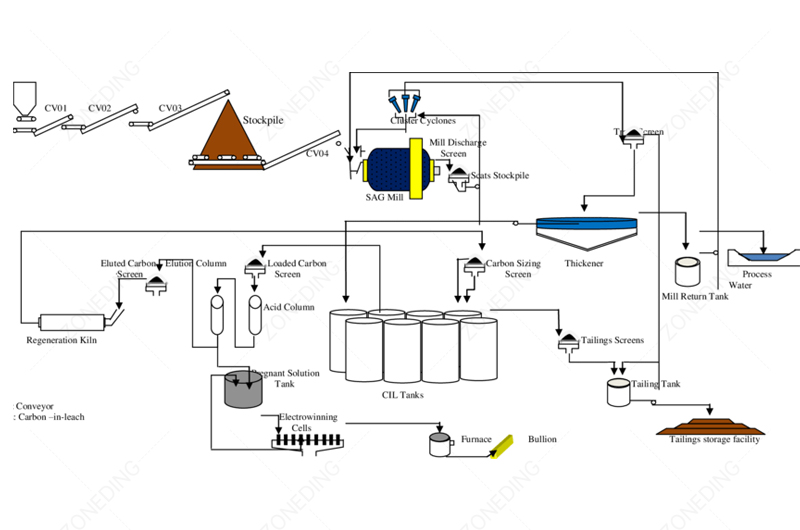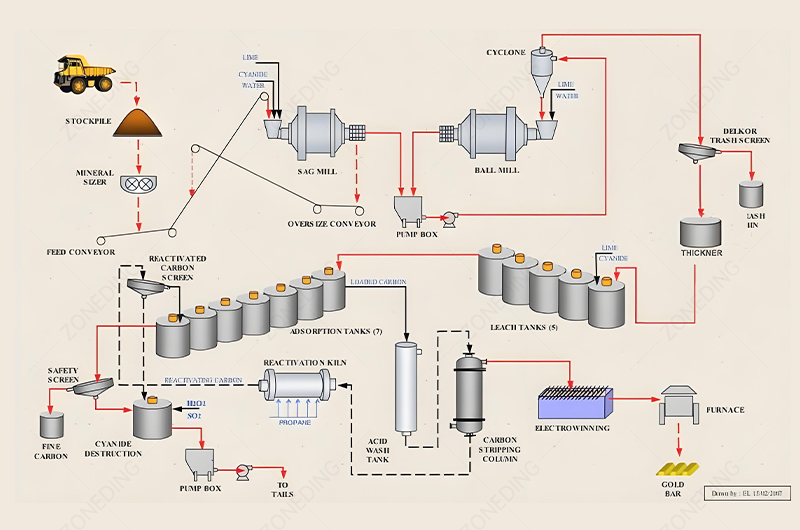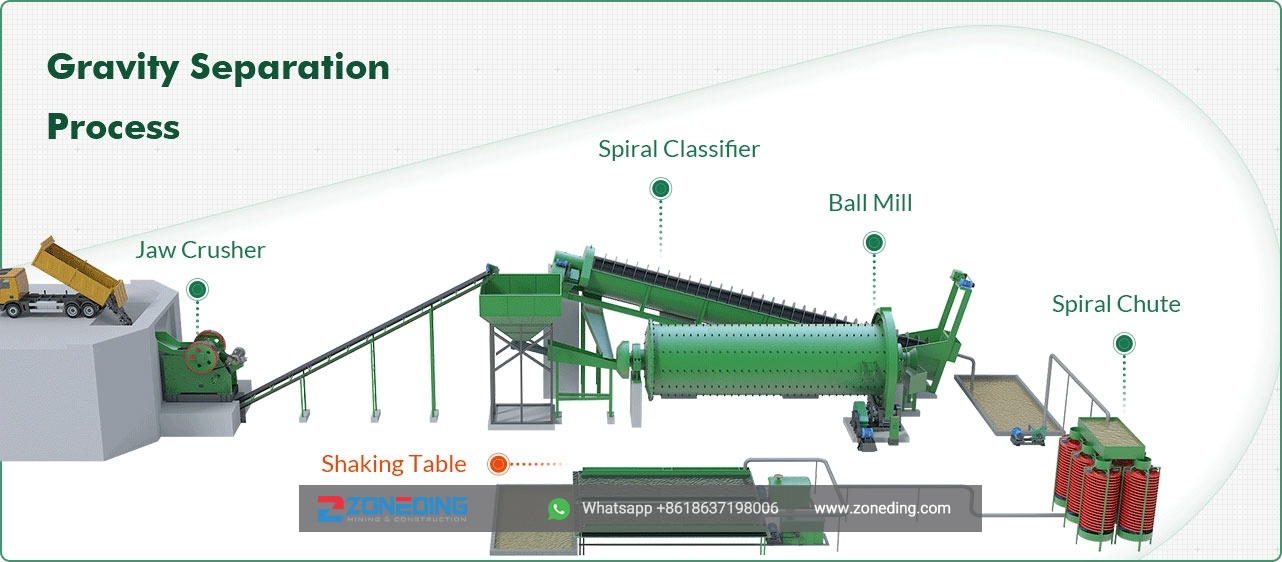Dry Sand Making VS Wet Sand Making Process: A Producer’s Guide
3462How does the sand making process affect quality? Compare dry vs. wet methods on efficiency, fineness modulus, and plant setup for optimal results.
View detailsSearch the whole station Crushing Equipment
Oxidized gold ore is the backbone of the global gold industry. Nature has done the hard work, breaking down tough sulfide minerals and making the gold chemically accessible. But this “easy” ore is full of traps.

Choosing the right gold extraction process is not about theory; it is about matching the technology to your ore’s physical and chemical properties. The key is to understand your ore’s grade, particle size, and especially its clay content before you decide.
The biggest challenge in most oxidized gold ore processing is not chemistry, it is physicality. Specifically, clay. Clay will choke your process and steal your profits faster than a bad assay. Let’s look at the four main approaches and the hard-won lessons that go with each.
Do not buy a single piece of equipment until you have answered these questions. The answers will dictate your entire flowsheet and business model.
Before any decision, a detailed mineral processing test is mandatory. It must determine the ore’s head grade, gold particle size distribution, clay content and type, and cyanide leach characteristics. This data is non-negotiable.
These are the vital signs of your ore body.

This is a game of scale and patience. It is the definition of a low-cost, bulk tonnage operation.
Gold heap leaching is ideal for large-scale, low-grade (<1.5 g/t) oxidized gold mines. Its success depends entirely on the ore’s permeability, which is its ability to allow the cyanide solution to trickle through the stacked heap.
Heap leaching has the lowest capital cost per ton, but it comes with trade-offs.
| Aspect | Description | Operational Insight |
|---|---|---|
| The Process | Crushed ore is stacked on a lined pad and irrigated with a weak cyanide solution. The gold-bearing solution is collected and processed. | A slow process. Recovery takes months or years. You sacrifice speed and some recovery for low upfront cost. |
| Critical Failure Point | Poor Permeability. Clay and fine particles can block the spaces within the heap, preventing the solution from contacting the ore. This creates “channeling” and leaves large parts of the heap unleached. | Agglomeration is not optional. For ore with any clay, tumbling it with cement binder and cyanide in a drum is essential. This creates durable pellets, locking in the fines and preserving the heap’s permeability. |
| Best For | Massive, low-grade deposits where you can move mountains of material cheaply. The ore must be structurally competent. | Not suitable for high-clay or very high-grade ores where locking up valuable gold for years is not economical. |
This is the high-tech, high-efficiency workhorse of the industry. When the ore is too clayey or the gold is too fine for heap leaching, this is often the answer.
Yes, the Carbon-in-Leach (CIL gold processing) and Carbon-in-Pulp (CIP process) are the best methods for clay-rich or fine-grained ores. By grinding the ore into a slurry, they completely bypass the permeability issues that plague heap leaching.
This method is about total control, but that control comes at a price.


| Aspect | Description | Operational Insight |
|---|---|---|
| The Process | Ore is ground into a fine pulp and flows through agitated leaching tanks. Cyanide dissolves the gold, and activated carbon is added to adsorb the dissolved gold directly from the pulp. | It must be operated with the precision of a chemical plant, requiring constant process control of pH, cyanide, and dissolved oxygen. It is complex but highly efficient. |
| Critical Failure Point | “Preg-Robbing” Ore. Natural carbon in the ore can “rob” dissolved gold from the solution before your activated carbon can. | CIL is the direct solution to this. By having activated carbon present during leaching, the dissolved gold will preferentially adsorb onto the highly active added carbon. This is the main difference from CIP, where leaching happens first. |
| Best For | Higher-grade ores (>1.5 g/t) and ores with high clay content or preg-robbing characteristics. It offers the highest recoveries (90-97%) and is very fast (hours, not months). | Highest capital and operating cost due to the power-hungry grinding circuit and complex desorption electrolysis system. |
This is about getting the “easy” money first. It is the oldest gold beneficiation process in the world, and it is still incredibly relevant.
Gravity separation for gold should be a priority whenever an ore contains even a small amount of coarse, free gold. It is not a complete process on its own but a critical, low-cost first step before leaching to recover gold that cyanide would miss.
Ignoring gravity gold is one of the most common and costly mistakes in plant design.

| Aspect | Description | Operational Insight |
|---|---|---|
| The Process | Uses the high density of gold to separate it from lighter waste rock. Modern plants use centrifugal concentrators, jig separators, or shaking tables, often placed within the grinding circuit. | The return on investment for a gravity circuit is extremely high. A single coarse gold nugget can take days to dissolve in cyanide and would be lost to tailings in a 24-hour CIL circuit. Gravity recovers it instantly. |
| Critical Failure Point | The Nugget Effect. Relying solely on cyanide for an ore with coarse gold results in low recovery. The cyanide simply does not have enough time to dissolve large particles. | By removing coarse gold upfront with a gravity circuit, you improve the financial stability of the operation. Even if the leach plant has problems, you are still producing a high-value gravity concentrate every day. The payback period is often short. |
| Best For | Almost any oxidized ore. The presence of even 10-20% gravity-recoverable gold makes this addition highly profitable. | Not a standalone solution for ores where gold is exclusively microscopic. |
Real-world ores are rarely simple. They are often messy, with a mix of different characteristics. The most profitable solution is often a hybrid approach.
Complex oxidized ores are best treated with a combination of processes. A common and highly effective strategy is to use a gravity circuit to recover coarse gold, followed by a CIL circuit to leach the fine gold from the gravity tailings.
This approach allows you to optimize the recovery for each type of gold present in your ore.
This is where metallurgy meets economics. The technically “best” process might not be the most profitable one for your specific situation.
The choice is a balance between your ore’s properties (grade, clay, particle size) and your financial constraints (capital cost vs. operating cost). Low-grade ore and a low budget demand heap leaching. High-grade ore and available capital favor the high recovery of a CIL plant.
Your gold mine feasibility study will analyze these trade-offs.
| Factor | Heap Leaching | CIL / CIP | Gravity Circuit |
|---|---|---|---|
| Ore Grade | Low (<1.5 g/t) | High (>1.5 g/t) | Applicable to all grades |
| Clay Content | Very sensitive; requires agglomeration | Not sensitive | Not sensitive |
| Capital Cost | Low | High | Very Low |
| Operating Cost | Low | High | Very Low |
| Recovery Rate | Low (50-75%) | High (90-97%) | Varies (5-50%) |
| Processing Time | Months / Years | Hours | Instant |
A generic solution is a recipe for failure. Your mine is unique, and your gold ore processing equipment must be selected and sized specifically for your ore.
We provide a complete mineral processing EPC solution that starts with your ore. Send us a representative sample, and our metallurgical lab will conduct a thorough analysis. Our engineers will then design a custom-fit process flowsheet and provide a detailed equipment configuration and quote at no charge.
This is the only way to ensure your investment is sound and your plant is designed for maximum profitability from day one.
Choosing the right gold extraction process for oxidized ore is a critical decision. It requires a deep understanding of your ore’s personality and a realistic view of your budget. Start with the science, test your ore thoroughly, and you will build a plant that is profitable for years to come.
How does the sand making process affect quality? Compare dry vs. wet methods on efficiency, fineness modulus, and plant setup for optimal results.
View detailsThis article explains the gold elution process. Understand its main advantages, typical problems that can arise, and how to solve them for better performance.
View detailsDiscover key equipment for efficient copper dressing plants. Learn about crushing, grinding, flotation, and dewatering machines to optimize mineral processing.
View detailsLooking for efficient tungsten extraction? Discover our range of gravity separation equipment designed to maximize recovery rates and improve your workflow.
View detailsWe use cookies to ensure that we give you the best experience on our website. If you continue to use this site we will assume that you are happy with it.
Privacy Policy